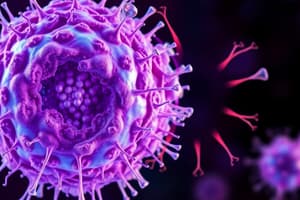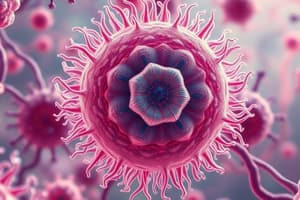Podcast
Questions and Answers
What is the primary purpose of meiosis in cell division?
What is the primary purpose of meiosis in cell division?
- To reduce the chromosome number for sexual reproduction (correct)
- To repair damaged somatic cells
- To produce daughter cells with the same chromosome number
- To replicate DNA for growth
During which phase of the cell cycle does DNA replication occur?
During which phase of the cell cycle does DNA replication occur?
- G1 phase
- Mitotic phase
- S phase (correct)
- G2 phase
Which of the following correctly describes the relationship between cells, tissues, and organs?
Which of the following correctly describes the relationship between cells, tissues, and organs?
- Cells are independent and do not form tissues
- Cells are organized into tissues which form organs (correct)
- Organs function without interactions between them
- Tissues are composed of organ systems
What role does ATP play in cellular activities?
What role does ATP play in cellular activities?
Which process extracts energy from nutrients through chemical reactions?
Which process extracts energy from nutrients through chemical reactions?
What characterizes prokaryotic cells in comparison to eukaryotic cells?
What characterizes prokaryotic cells in comparison to eukaryotic cells?
Which component of eukaryotic cells is primarily responsible for energy production?
Which component of eukaryotic cells is primarily responsible for energy production?
Which of the following statements accurately describes the plasma membrane?
Which of the following statements accurately describes the plasma membrane?
What is the primary function of ribosomes in a cell?
What is the primary function of ribosomes in a cell?
What role do lysosomes play within a eukaryotic cell?
What role do lysosomes play within a eukaryotic cell?
Which transport mechanism requires energy to move substances against their concentration gradient?
Which transport mechanism requires energy to move substances against their concentration gradient?
How do cells communicate with each other?
How do cells communicate with each other?
Which structure is primarily responsible for storing water, nutrients, and waste products in plant cells?
Which structure is primarily responsible for storing water, nutrients, and waste products in plant cells?
Flashcards
Prokaryotic cell
Prokaryotic cell
A type of cell lacking a nucleus and membrane-bound organelles. Found in bacteria and archaea.
Eukaryotic cell
Eukaryotic cell
A complex cell containing a nucleus and membrane-bound organelles (e.g., mitochondria, ribosomes). Found in plants, animals, fungi, and protists.
Cell membrane
Cell membrane
The outer boundary of a cell, composed of a phospholipid bilayer, controlling what enters and leaves the cell.
Passive transport
Passive transport
Signup and view all the flashcards
Active transport
Active transport
Signup and view all the flashcards
Mitochondria
Mitochondria
Signup and view all the flashcards
Cell signaling
Cell signaling
Signup and view all the flashcards
Ribosomes
Ribosomes
Signup and view all the flashcards
Mitosis function
Mitosis function
Signup and view all the flashcards
Meiosis function
Meiosis function
Signup and view all the flashcards
Cell cycle phases
Cell cycle phases
Signup and view all the flashcards
DNA replication phase
DNA replication phase
Signup and view all the flashcards
Cellular respiration function
Cellular respiration function
Signup and view all the flashcards
Study Notes
Cell Structure and Function
- Cells are the basic units of life, exhibiting diverse shapes and sizes adapted to their specific functions.
- All cells share fundamental characteristics, including a plasma membrane, cytoplasm, and genetic material (DNA).
Prokaryotic Cells
- Prokaryotic cells (bacteria and archaea) lack a nucleus and membrane-bound organelles.
- Their DNA is located in a nucleoid region.
- Cytoplasm contains ribosomes for protein synthesis.
- Cell wall composed of peptidoglycan (bacteria) or other components (archaea).
- Possess smaller size compared to eukaryotic cells.
Eukaryotic Cells
- Eukaryotic cells (plants, animals, fungi, protists) have a nucleus and membrane-bound organelles, increasing their complexity and efficiency.
- Nucleus contains the cell's DNA organized into chromosomes.
- Ribosomes are present for protein synthesis.
- Mitochondria are the powerhouses of the cell, responsible for energy production (ATP).
- Endoplasmic reticulum (ER) is involved in protein and lipid synthesis, modification, and transport.
- Golgi apparatus modifies, packages, and sorts proteins and lipids.
- Lysosomes and peroxisomes are involved in waste breakdown and detoxification.
- Vacuoles (large in plant cells) store water, nutrients, and waste products.
- Cytoskeleton provides structural support and facilitates intracellular movement.
- Plasma membrane regulates the passage of materials into and out of the cell.
- Chloroplasts (present in plant cells) perform photosynthesis.
Cell Membrane
- Composed of a phospholipid bilayer with embedded proteins.
- Selectively permeable, regulating the passage of substances into and out of the cell.
- Fluid mosaic model describes its dynamic structure.
- Proteins play crucial roles in transport, signal transduction, and cell recognition.
Cellular Transport
- Passive transport (diffusion, osmosis) doesn't require energy.
- Active transport (protein pumps) requires energy to move substances against their concentration gradient.
- Endocytosis (phagocytosis, pinocytosis) brings materials into the cell.
- Exocytosis releases materials from the cell.
Cell Signaling
- Cells communicate with each other through various mechanisms.
- Signal transduction pathways transmit information from outside to inside the cell.
- Receptor proteins bind to specific signaling molecules.
- Intracellular responses vary depending on the signal received.
Cell Division
- Mitosis is the process of cell division for growth and repair in somatic cells.
- Meiosis is the process of cell division for sexual reproduction, reducing chromosome number.
Cell Cycle
- The cell cycle consists of interphase (G1, S, G2) and the mitotic phase (mitosis and cytokinesis).
- DNA replication occurs during the S phase.
Specialized Cell Types and Tissues
- Different cells are specialized for specific functions.
- Cells are organized into tissues.
- Tissues are grouped into organs.
- Organs interact to form organ systems.
Cell Interactions
- Cells interact with each other through direct contact (gap junctions) or indirect signaling.
Cellular Metabolism
- Anabolic and catabolic pathways govern chemical reactions within cells.
- Cellular respiration is the process of extracting energy from nutrients.
Cellular Energetics
- Cells require energy to perform various functions.
- ATP acts as the primary energy currency of the cell.
Studying That Suits You
Use AI to generate personalized quizzes and flashcards to suit your learning preferences.




